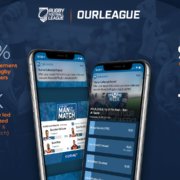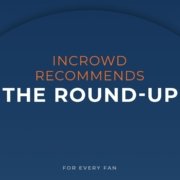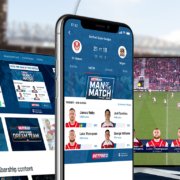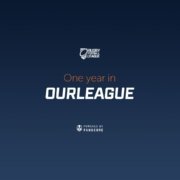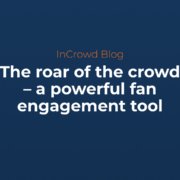In times of crisis, sport has always been a reliable and constant presence, providing its fans with a much needed emotional distraction. When sports closed their doors in March for the first time since WW2, showing the world that they too were not immune to this disease, it seemed to bring home to many people how serious this situation was.
InCrowd is a business that has spent the last five years championing the importance of engaging fans digitally as audience consumption changes dramatically. However, we could never have predicted that it would take a pandemic such as this to highlight the importance of a retained and engaged digital audience, now more than ever. Without live sport, clubs and leagues have been burdened with the tasks of keeping their audiences engaged and continuing to service commercial agreements whilst planning for a world without matchday income in which digital channels become a vital centrepiece.
In this paper, we look at how InCrowd clients are successfully navigating a situation that no one was fully prepared for, implementing new strategies and uses for their digital engagement tools whilst battling major digital media outlets to maintain fans’ attention. In addition we gather valuable insight from sports marketing experts on what we can expect for sports on “the other side” and present InCrowd’s four-step approach for rights holders, guiding them towards creating their own positive outcome to the COVID-19 crisis and placing them in better stead for when sport makes its triumphant return.
Many weeks have now passed since sport effectively went into hibernation and as the green shoots of hope emerge with the German Bundesliga having started behind closed doors and the English Premier League setting a provisional date for a similar resumption in a few weeks time. At the time of writing, rumours began circulating of other sports around the world putting together proposals to find a way back into action.
Adapting to the unknown
This situation is unprecedented, inescapable, very real and it won’t ‘just go away’. As ever, there are those that are better equipped to adapt and through this there will be clubs, leagues and NGBs that will be able to come out of this crisis in a stronger position than others.
One trend that emerged early in the UK lockdown period was that clubs are better able to retain fan engagement than Leagues and NGBs, with some exceptions of course.

Perhaps this is no surprise due to the allegiance and draw towards the club brands, however, after analysis of the content themes doing well, the majority of the high performing categories could just as easily be published by leagues and NGBs, such as iconic moments, classic matches, legends content and retrospective voting i.e. “team of the decade”.
Focus on Community
One organisation that has performed particularly well is Crystal Palace Football Club. Taking a look at mobile app engagement only, Crystal Palace have dropped just 14% of digital engagement comparing pre and post lockdown. This compares very favourably against a club average of 28%, and with two other significant football clubs that have reduced engagement by 39% and 45% during this time.
“The lack of football really has reminded us all just how much the game is loved and the huge role that it plays in many supporter’s lives.”
James Woodroof, Head of Content & Production at Crystal Palace FC explained the strategy behind their success:
“Two months of no football has been unquestionably challenging for all club editorial teams. Of course, in the grand scheme of things – these challenges and indeed the corresponding digital metrics are inconsequential, but nevertheless, the lack of football really has reminded us all just how much the game is loved and the huge role that it plays in many supporter’s lives. Therefore, one could argue that our role in providing engaging editorial content to give people an escape matters more than ever before.
As a club, we have been even more focused on the importance of our role within the community, and specifically on supporting those who are most vulnerable. Extremely early on in the crisis, we were sharing health and wellbeing advice from our club doctor for supporters self-isolating, as well as offering support to all 1,200 of our season ticket holders over the age of 70.
Our Chairman to his credit has been immensely proactive with statements regarding the club’s position on matters related to the pandemic, and also offering insightful thought leadership in terms of the various scenarios at a league level. Our manager penned a wonderful open letter to supporters, and these two articles have been our most read of all time. Our open lines of communication with our fans throughout this period about everything we are doing will undoubtedly have had an impact on our relatively healthy digital engagement levels.
We are extremely lucky to have a team of exceptionally gifted writers, photographers, social media experts, and production unit – and with the amount of time granted to us by the pandemic, that has helped us diversify our content in many ways. We have shown several classic matches in their entirety that have lay dormant for many years, supported by video interviews with the stars of those games as bonus content for our free members.
There have been regular Instagram Live interviews with first team players, even interactive pub quizzes. We also dusted off old Season Review DVDs, which were pay-per-view to raise money for our Foundation.
There have been countless phone conversations with former players that have been made into long-form reads, and we’ve engaged directly with supporters by asking them to share examples of their favourite club memorabilia that they’ve acquired, which has been illuminating for us – with several spin-off stories in the pipeline.
Finally, for several months, our video team have been working on a project where we shared our claim to be the oldest football club in the world through a fantastic short film, having been informed about new evidence clearly showing our lineage to the original Crystal Palace FC of 1861. This story has stimulated fierce debate around the world, and we have seen huge interest in our historical content since that launch.”
Focus on Content
Whilst in general clubs seem to be out-performing Leagues and NGBs, one governing body that continues to excel digitally, even during this period, is UEFA. In fact UEFA Champions League Facebook and IGTV platforms generated the highest number of interactions per video across all major global leagues and federations last month.
For our content team at InCrowd, which manages UEFA’s social content, there has recently been significant focus on converting digital audiences through to UEFA.tv subscriptions. Rather than letting the lack of live events scupper their targets, the team, along with their colleagues at UEFA HQ, have been innovative in their strategy to continue the positive trend of sign-ups by, like many right owners, turning to archive content. UEFA decided to create an entirely new brand utilising this archive footage and the result was the UEFA Classics campaign.
“In a planned two-month campaign, the KPI for UEFA.tv registrations was hit within ten days, with organic UEFA social media accounts being the primary source of new subscribers.”
Sam Adams, who heads up the content division at InCrowd, explained:
“The centrepiece of the Classics campaign was legendary UEFA Champions League, UEFA Europa League & EURO matches, replayed in full as live on UEFA.tv (UEFA’s OTT platform). The games went out every weekday at 17CET, the sweet spot time to hit all the key global markets. Vital to its success has been a fully integrated cross-platform collaboration plan in which UEFA’s other owned and operated channels switched focus to become referral drivers to UEFA.tv.
Our social media strategy concentrated on using Twitter cards, which have proved to be the biggest referrer, and Instagram Stories to drive fans to UEFA.tv. These posts were built upon by shoulder content tapping into fan nostalgia, while UEFA ambassadors who played in those games were also utilised (e.g. in Instagram Q&As). Classics-related video accounted for 12.5m views on Instagram the week of 4 May or 22% of all video views, demonstrating that the content was holding its own as a standalone strand.
The native platforms –– UEFA.com & competition apps –– published supporting content (video, text and still imagery) such as best moments from corresponding seasons, related match highlights, scene-setters and historical colour pieces. Following the initial success, corresponding ‘throwback seasons’ were added to each week’s content plan to enable existing competition sponsors to reignite branded partner posts on official channels.
It was then important for us to dial back the Classics referral posting frequency after its early surge, redressing the balance between our short-term campaign promotion priority and our long-term strategy to retain high engagement across our operated channels.”
Both Crystal Palace and UEFA have shown the power of utilising cross-platform marketing strategies to amplify their content and objectives; social as volume driver and converter, with owned channels hosting and converting audiences through to action like OTT subscription. But even owned channels are showing variation during this period with apps and websites performing very differently.
Apps vs Web Behaviours
The relationship we’ve traditionally observed between our clients’ App & Web audiences has been consistent across sports & types of rights holders. Web audiences can often be up to 10x the size of their counterparts, but Apps make up for this with much higher user-level engagements; the likes of Sessions per User, Page Views, Pages per Session, and Duration per Session are significantly higher in App communities. This is unsurprising in relation to their respective positions in the traditional sporting funnel –– Web typically comes into its own at the top end whereas App is stronger towards the bottom at engaging, converting and retaining audiences. But how has this landscape changed as a result of Covid-19? Below, you will find a graph that plots the percentage of digital usage that App represents, where app and website combined for a single rights holder equals 100%.
Across a cross-section of Leagues & Clubs, there is a consistent average of ~10% of digital users use the App. The global pandemic hasn’t hugely shifted this behaviour, Web & App have both seen user volumes drop at fairly similar rates since Covid-19 began. However, we noted during our research that, for 65% of the clients we reviewed in this study, the proportion of App Users has actually increased (i.e. the number of web users saw a steeper decline than app users), but the ultimate average was tempered by 35% of clients who saw particularly significant shifts in app vs web usage behavior, towards web. Notably, as demonstrated in a previous graph, it has been leagues & competitions, more than clubs, that have experienced this greater decline in usage.
Regardless of rights holder type, where we have seen the most significant changes in behaviours during Covid-19 has been in the user engagement-based metrics. Our Apps are designed to create surges of Sessions and subsequent higher Page Views due to an array of content types, fan engagements, and communication triggers. This creates a hive of activity as higher-affinity fans have a larger variety of reasons to continually return. Over the last couple of months, we have seen the high shares of app sessions & page views drop to the ~30% mark where they were previously sitting closer to 40% & 50% of total engagement respectively. One conclusion we can draw traces back to a slowing of App content production – the cornerstone of the channel’s strategy – which has naturally declined while sporting events aren’t happening, as well as the high usage of apps typically seen in-line with matches, where fans utilise the apps for stats, commentary and are often tempted to open via match related push notifications such as line-ups. Less production = less engagement.
Web usage metrics have also dropped since March, but less pronounced. This is an expected outcome, with the majority of fans checking in occasionally from a search to retrieve a specific piece of information related for fixtures, results and live scores. Reductions in content production due to Covid have essentially had less of an impact on the audience & their expectation of the channel. Overall, it’s clear that, even in these unprecedented times, Apps are still performing very well in taking big shares of overall digital engagement behaviours considering their relative audience size.
What has started to become apparent across sports & client types over the last 3 months is that general engagement, regardless of channel, is simply beginning to drop at a sharper rate. While clients have tried to pivot their content strategies to keep capturing fan attention (so far resulting in mixed success across the board), April represented a significant drop across most metrics from the perhaps more novelty period of March. This is an intriguing opportunity to more deeply understand a fan’s relationship with sports, and how a period of inactivity leading to dwindling fan attention could actually be used to better tune marketing automation and audience management moving forward.
Naturally, the recent announcements regarding the resumption of competition for many sports is dramatically reversing this decline, but we shouldn’t forget the lessons this teaches us about how important it is to be able to engage fans with diverse content outside of matches. If this were addressed it would lead to a softening of typical downward engagement trends seen in the off-season or even mini-drops seen between match weekends and competitive events.
The Battle For Fan Attention
Regardless of the impact of this global pandemic, the need for sports rights holders to diversify and upweight content production was already a key theme in the industry, mirrored by the significant appointments of personnel with media backgrounds into organisations such as The Jockey Club, Premiership Rugby and the former shortlist for the Premier League football CEO position. The approach is designed to enable these organisations to successfully capture their fair share of audience attention from their competitors and partners in media.
Too often rights holders are losing out to major digital outlets in this fight, having a significantly detrimental impact on broader commercial revenues due to the intrinsic link between audience volume and engagement levels to the size of direct and indirect (sponsorship) revenues.
This is evidenced to some degree in the graph below which shows engagement with one major rights holders website (blue) and engagement from the league’s fans with league related content on third party websites (red) two weeks before and several weeks after lockdown.
What is clear is despite no matches taking place, the aggregate of third party channels experienced a smaller drop of audience engagement. These channels are typically media organisations therefore more nimble and able to switch gears to produce both COVID related and other general content in order to minimise the negative impact.

Max Jolly, CEO of digital marketing business Arcspire commented:
“The challenge for a rights holder is how to be relevant amongst the major digital media outlets. How do they retain uniqueness that fans can only consume through them?”
“It comes down to rights holder’s providing a reason for fans to go to their own site or app. At what point am I opening a new browser tab and typing in the rights holders web address (or opening the app)? What fan need is the rights holder fulfilling at that point that they can’t fulfil elsewhere more easily? As a fan, I go to Facebook/Twitter/Instagram etc every day and can get my updates and news there. I may also go to my preferred news channel every day e.g. Sky News, BBC Sport, The Times, The Daily Mail etc and get my news there. I might even go to a specialist sports forum e.g. NewsNow, RugbyPass, LiveScore etc to dive deeper into my passion.
The challenge for rights holders is how to be relevant amongst these options. How do they retain some unique content or element of the relationship that fans can only consume through them? This is a lot harder when live sport isn’t being played. I think a lot comes down to good content and thinking editorially about what content is where and how it is structured and shared. This could mean sign-posting content on social channels but requiring people to come to their site to consume it fully. Once there, how is the site structured to give them the next best piece of content and keep them there, and engaged, and with a reason to come back.”
Max is illustrating a core challenge we focus on at InCrowd; the ability for rights holders to capture and engage fans. Both of which are the first two steps towards successful conversion, where conversion means an outcome which supports the commercial objectives of the rights holders i.e. a fan registration, a direct transaction or engagement with a sponsored asset. We aim to align different technologies to each part of this process and illustrate this in a typical funnel:

Whilst several challenges that might occur for rights holders that aren’t able to digitally maximise their core asset are obvious, Max highlights a slightly less obvious threat of losing this audience to more sophisticated digital players. “The interesting shift that Covid-19 may accelerate is the digital giants winning more broadcast rights. The ‘digital-winners’ of Covid-19 will have their cash reserves enlarged and rights holders may be looking to carve up broadcast deals to get maximum value. This represents both opportunity and threat. The opportunity is clear: to bring in more revenues from new ‘alternative’ broadcasters. The threat is a little more hidden. The likes of Facebook, Instagram, Google, YouTube etc are using their engagement mechanics to capture audience attention and discussion with little investment required in the content. Every rights holder has to build their audience and connect with fans on these platforms.
Social networks simply have the scale of audience and this is therefore where most fans reside digitally too. Whilst rights holders get to connect with fans, the digital giants get to hoover up data on fans. This enables them to offer these fan audiences to any advertiser that is interested. The digital giants have much better data on fans, capture the conversation as well as the emotion, which is sports secret sauce. So as more and more broadcast rights, highlights, memes etc are shared on these channels the bigger the threat grows.
Who has the ability to turn passions into purchases? The likes of Google and Facebook are able to offer a ‘full-funnel’ solution to brands, totally independent of any official sponsorship. I can watch the highlights on YouTube and then be targeted when I search on Google. I can watch the match on Amazon Prime and then be targeted when I’m shopping on Amazon. In this world, why does a brand need sponsorship at all when the digital giants have the data and gateway to fans that they need?
If any evidence was needed, Google, Facebook and Amazon recently announced their Q1 2020 results; together they grew by almost $7billion in advertising revenues in a quarter. This represents over 3x the annual growth in global sponsorship revenues forecasted by WARC in 2020. Marketing directors are voting with their budgets. They want the accountability and performance that these channels provide.”
The InCrowd Solution
“When sport returns, digital is going to be a more prominent focus than ever before, a huge acceleration in a pattern of behaviour.”
The COVID-19 crisis will change the way in which sports rights holders engage with their audiences forever. As the head of marketing a Championship football club said to me during lockdown – “digital is all we have now”. But even beyond the “now”, when sport returns, digital is going to be a more prominent focus than ever before, a huge acceleration in a pattern of behaviour. So what can sports rights holders do to ensure they are one of the organisations that thrive in this new era:
- Think and act like a media business: For a rights holder, your greatest asset is your fans, yet traditionally, sports organisations prioritise the monetisation of physical assets and real estate. At the core of a media business is it’s audience and content production is the centre of success. Offer fans experiences that encourage them to engage with you on a regular basis that goes beyond the pre-match, in-match and post-match hygiene and invest in content production and delivery.
- Give fans a reason to visit your owned channels: Develop a content and technology strategy that considers deployment by channel. Know what is pushed to social vs what is reserved for own channels, perhaps with even further variations for Web vs App and logged in vs logged out. What can your own channel own that third parties don’t have? Fantasy Games, Specific Player Access and even utilities like Mobile Ticketing (which for one InCrowd client drove 24% increase in general app usage) are all reasons for fans to visit your platforms.
- Track, measure, analyse and react: The beauty of digital engagement is the ability to know what is working and do more of it! Whilst lots of digital metrics are tracked by all organisations, many are too high level to offer real insight. We need to understand not just overarching traffic numbers, but the details of engagement by content type, by audience type, and in relation to external factors such as time and form. Use this information to build the successful engagement formula for your organisation.
- Know your Value Per Fan and make it a key KPI: To be a successful “media business” digital engagement can’t be pure vanity numbers. We need to focus on driving users to valuable engagements; direct ROI, data capture or sponsor interactions. Define what success from a digital user or user group looks like by measuring your direct and indirect value per digital fan. Through your approach to point 2, measure this value continually and build strategies to drive more of it.
InCrowd is here to help plan & deliver all of the above. To find out about how we can work together to navigate this new world of sports engagement, get in touch!
InCrowd Online:
Twitter
LinkedIn
 85,000+ interactions with Our Leagues polls, predictor and player of the match vote.
85,000+ interactions with Our Leagues polls, predictor and player of the match vote.
